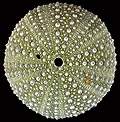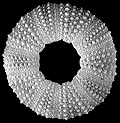The Echinoid Directory
Evechinus Verrill, 1871, p. 583
| Diagnostic Features |
|
|---|---|
| Distribution | Pliocene, Australia, Pleistocene to Recent of New Zealand and the Kermadec Islands. |
| Name gender | masculine |
| Type | Echinus chloroticus Valenciennes, 1846, by original designation. |
| Species Included |
|
| Classification and/or Status |
|
| Remarks |
|



